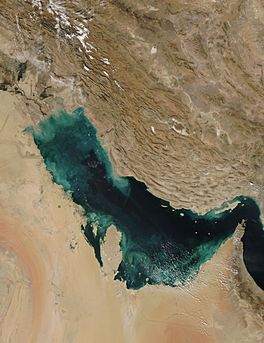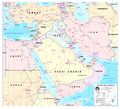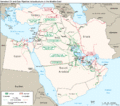Persian Gulf facts for kids
Quick facts for kids Persian Gulf |
|
|---|---|

Persian Gulf from space
|
|
| Location | Western Asia |
| Type | Gulf |
| Native name | خَلِیْج فَارْس (Persian) ٱلْخَلِيْج ٱلْعَرَبِي (Arabic) Error {{native name checker}}: list markup expected for multiple names (help) |
| Primary inflows | Gulf of Oman |
| Basin countries | Iran, Iraq, Kuwait, Saudi Arabia, Qatar, Bahrain, United Arab Emirates and Oman (exclave of Musandam) |
| Max. length | 989 km (615 mi) |
| Surface area | 251,000 km2 (97,000 sq mi) |
| Average depth | 50 m (160 ft) |
| Max. depth | 90 m (300 ft) |
The Persian Gulf is a large body of water located in the Middle East. It is an extension of the Gulf of Oman and lies between Iran and the Arabian Peninsula. This area is well-known for its rich marine life, including many fish and beautiful coral reefs. Deep in its waters, you can also find pearl oysters, which makes the area important for pearl fishing.
The Persian Gulf was in the news during the Iran–Iraq War (1980-1988). Both sides attacked oil tankers belonging to each other. Later, when Iraq invaded Kuwait in 1991, this led to the Gulf War. While this war was called "Desert Storm," most of the fighting happened on land. In the Persian language, "khalīj-e-Fars" means "Persian Gulf."
Contents
Geography of the Persian Gulf
The waters of the Persian Gulf cover a huge area of 233,000 square kilometers. To the east, it connects to the Gulf of Oman through a narrow passage called the Strait of Hormuz. To the west, it connects to a large river delta called Shatt al-Arab. Here, the waters from two major rivers, the Euphrates and the Tigris, flow into the Gulf.
The Persian Gulf is about 989 kilometers long. Its narrowest point between two land areas is 56 kilometers. The water in the Gulf is generally not very deep. The deepest part is only 90 meters, and the average depth is just 50 meters.
Many countries have coastlines along the Persian Gulf. Moving clockwise from the north, these countries include Iran, the United Arab Emirates, Saudi Arabia, and Qatar (which is on a peninsula off the Saudi coast). Also, there is Bahrain on an island, and Kuwait and Iraq in the northwest. Many small islands are also found within the Persian Gulf.
Oil and Gas in the Persian Gulf
The area in and around the Persian Gulf holds the world's largest amounts of crude oil. Because of this, industries related to crude oil are the most important ones here. For example, Al-Safaniya, the world's largest offshore oilfield, is located in the Persian Gulf.
Many countries with large amounts of crude oil are in this region. They are often called the Persian Gulf States. These countries are Iran, Bahrain, Kuwait, Oman, Qatar, Saudi Arabia, and the United Arab Emirates. Even though Iraq has a small part touching the Persian Gulf, it is usually not called a Persian Gulf State.
Historical Control
For about 200 years, from 1763 until 1971, the United Kingdom had some control over certain countries in the Persian Gulf. These included the United Arab Emirates and, at different times, Bahrain, Kuwait, Oman, and Qatar.
Images for kids
-
Persian Gulf at Night from the International Space Station, 2020.
-
The Achaemenid Empire and the Persian Gulf.
-
A painting of the British Expeditionary Force off Ras Al Khaimah in 1809.
-
Operation Earnest Will: A tanker convoy with United States Navy escort in 1987.
-
Khasab, Musandam, Oman.
-
Abu Dhabi, UAE.
-
Khobar, Saudi Arabia.
-
Bandar Abbas, Iran.
-
Dugong mother and her offspring in shallow water.
-
Spinner dolphins leaping in the Persian Gulf.
See also
 In Spanish: Golfo Pérsico para niños
In Spanish: Golfo Pérsico para niños




















